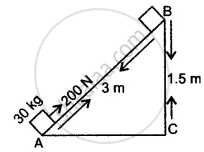Advertisements
Advertisements
प्रश्न
What happens to the work done when the dispacement of body is at right angles to the direction of force acting on it? Explain your answer.
उत्तर
When the force is perpendicular to the direction of motion, the work done in such cases is zero. We have a relation as,
W = FS cos θ
Where,
(W) - Work done
(F) - Force
(S) - Displacement
(θ) - Angle between force and distance
When the force is perpendicular to the direction of motion, cos 90° = 0, and hence the work done is also zero.
Example - The work done by the earth on a satellite moving in a circular orbit around it is zero because gravitational force of attraction and displacement of sattelite at any instant are perpendicular to each other.
APPEARS IN
संबंधित प्रश्न
When do we say that work is done?
Power spent by a body depends on the time for which it does work.
A box of weight 150 kgf has gravitational potential energy stored in it equal to 14700 J. Find the height of the box above the ground. (Take g = 9.8 N kg-1)
A body of mass 5 kg falls from a height of 10 m to 4 m. Calculate:
The loss in potential energy of the body,
A boy weighing 25 kgf climbs up from the first floor at height 3 m above the ground to the third floor at height 9m above the ground. What will be the increase in his gravitational potential energy? (Take g = 10 N kg -1)
Fill in the blank with suitable word :
1 joule is the work done when a force of 1 __________ moves an object through a distance of one __________ in the direction of __________.
A boy throws a rubber ball vertically upwards. What type of work, positive or negative, is done : by the force applied by the boy?
(a) by the force applied by the boy?
(b) by the gravitational force of earth?
Give one example each in which a force does (a) positive work (b) negative work, and (c) zero work.
Explain by an example that a body may possess energy even when it is not in motion.
Define the term 'work'. Write the formula for the work done on a body when a force acts on the body in the direction of its displacement. Give the meaning of each symbol which occurs in the formula.
The work done by a force acting obliquely is given by the formula : W = F cos θ ✕ s. What will happen to the work done if angle θ between the direction of force and motion of the body is increased gradually? Will it increase, decrease or remain constant.
A uniform circular motion is an accelerated motion. Justify it.
Explain the difference between a uniform linear motion and a uniform circular motion.
What is the SI unit of work?
Complete the following sentences:
The SI unit of work is ....... and of power is .......
A block of mass 30 kg is pulled up a slope, as shown in diagram with a constant speed, by applying a force of 200 N parallel to slope.
A and B are initial and final positions of block.

(i) Calculate the work done by force in moving the block from A to B.
(ii) Calculate P.E. gained by block. [g=10ms-2]
A is a push or a pull ______.
